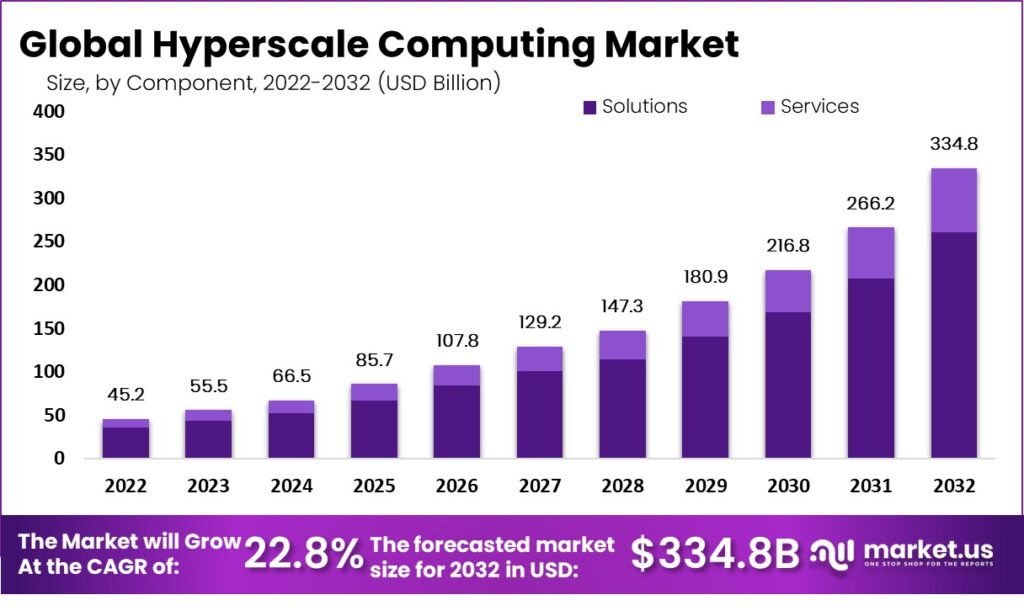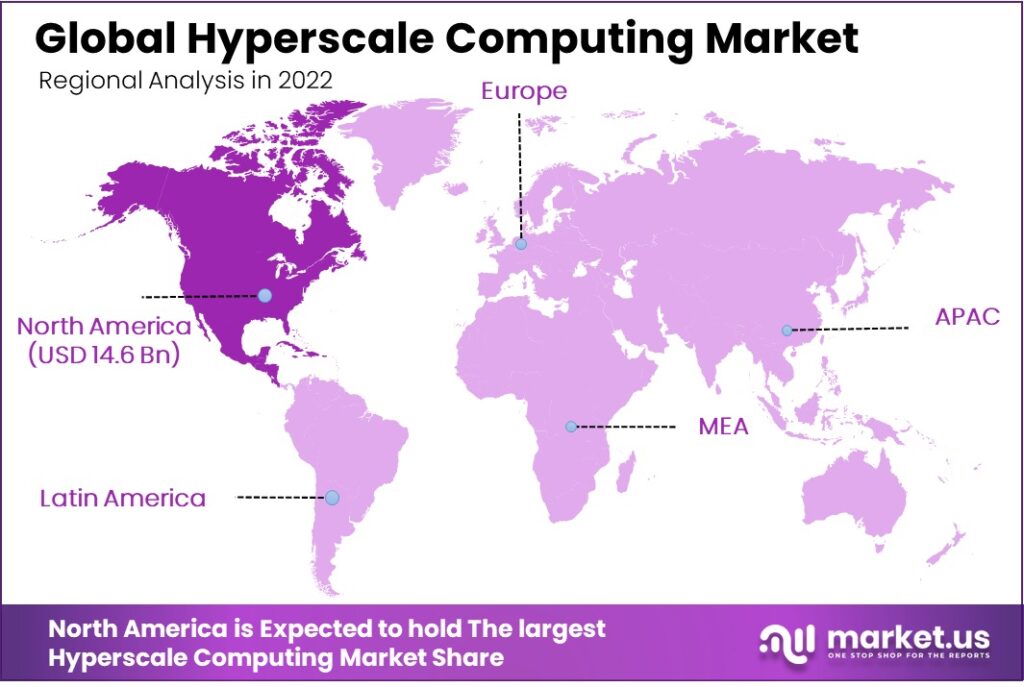Table of Contents
Based on data from Market.us, The global hyperscale computing market was valued at USD 66.5 billion in 2024 and is projected to reach USD 334.8 billion by 2032, growing at a CAGR of 22.8% over the forecast period. This rapid growth is fueled by the increasing demand for cloud computing, big data analytics, and artificial intelligence (AI) across industries. Businesses are investing heavily in scalable and high-performance computing infrastructure to manage vast amounts of data and support real-time processing.
Hyperscale computing is the technology behind the seamless scaling of data centers as the demand for digital resources increases. It involves a vast network of servers capable of expanding or contracting their capacity efficiently, supporting large-scale operations typically seen in major tech companies and cloud service providers. This technology ensures that additional compute, memory, networking, and storage resources are quickly available to meet growing demands without interrupting service.
The hyperscale computing market is vibrant and rapidly expanding, driven by the continuous growth of data and the need for powerful computing solutions. Companies like Amazon Web Services, Google Cloud Platform, and Microsoft Azure dominate this space, offering robust solutions that support massive, fluctuating workloads typical in today’s digital economy.

Key drivers of the hyperscale market include the increasing volume of data generated by businesses, the growing complexity of technology applications, and the widespread adoption of cloud services. Organizations are leveraging hyperscale to meet the demands of big data analytics and cloud computing, requiring infrastructures that can manage large amounts of data efficiently.
As digital transformation accelerates across industries, the demand for hyperscale computing solutions is surging. Businesses are seeking scalable, cost-effective solutions for data management and processing that hyperscale platforms uniquely provide. This shift is creating significant opportunities for existing cloud providers and new entrants aiming to offer differentiated, scalable services.
Hyperscale computing is at the forefront of technological advancements, with innovations in server architecture, virtual networking, and energy efficiency. These advancements enhance the ability of hyperscale data centers to manage vast networks of servers and vast data volumes, making them essential for modern digital infrastructures.
Key Insights
- The global hyperscale computing market is on a rapid growth trajectory. It is expected to reach USD 334.8 billion by 2032, expanding at a CAGR of 22.8% from 2023 to 2032. The rising demand for high-performance computing is fueling this impressive growth.
- The solutions segment dominates the hyperscale computing market, accounting for a 77.8% revenue share. Businesses are increasingly investing in scalable and high-performance solutions to manage their growing workloads efficiently.
- Among various applications, cloud computing holds the biggest market share at 30.6%. The demand for cloud-based services is skyrocketing as companies across different industries shift to digital platforms.
- The IT & telecommunication sector leads in adopting hyperscale computing, contributing to a 22.9% market share. Telecom companies benefit significantly from hyperscale infrastructure, experiencing better scalability, efficiency, and reduced operational costs.
- North America remains the largest market, holding a 32.4% revenue share.
Analysts’ Viewpoint
Investors are keenly eyeing this sector due to its promising returns. However, the substantial energy consumption of hyperscale data centers raises environmental concerns, leading to stricter regulations and the need for sustainable practices. Companies are increasingly co-locating new data centers with renewable energy sources like solar and wind power, along with battery storage, to address power supply reliability and meet net-zero targets.
From a consumer perspective, the demand for scalable and efficient computing solutions is paramount. Businesses are seeking infrastructure that can handle massive data volumes while ensuring cost-effectiveness and flexibility. The integration of advanced technologies, such as AI and machine learning, into hyperscale computing is enhancing operational efficiencies and decision-making processes.
Technological advancements are continually shaping the hyperscale market, with AI and machine learning enhancing the efficiency and scalability of hyperscale data centers. These technologies help in optimizing resource allocation, predictive maintenance, and overall operational agility, enabling businesses to handle increased data loads and complex computations more effectively.
Regional Analysis
North America’s prominent position in the global hyper-scale computing market, with a 32.4% revenue share, can be attributed to several key factors that distinguish the region as a leader in this field. Firstly, the region is home to a robust technological infrastructure that is conducive to the development and scaling of hyper-scale systems. This includes widespread high-speed internet access, advanced data center capabilities, and a mature cloud computing landscape, all of which are essential for hyper-scale operations.
Additionally, North America benefits from the presence of major technology giants such as Amazon, Google, and Microsoft, which not only pioneer innovations in hyper-scale computing but also invest heavily in developing new technologies and expanding their infrastructure. These companies drive the market forward through their continuous research and development efforts, leading to the rapid adoption of hyper-scale computing across various sectors including finance, healthcare, and e-commerce.
The region’s regulatory and business environment also plays a crucial role. North America offers a favorable business climate with policies that support technological advancements and data protection. This regulatory support is coupled with significant investments in cybersecurity, ensuring the integrity and security of hyper-scale computing environments. This not only attracts businesses that require massive computing power and data storage solutions but also reassures them about the safety of their data, a critical consideration in today’s digital age.

Report Scope
| Report Features | Description |
|---|---|
| Market Value (2023) | US$ 55.5 Bn |
| Forecast Revenue (2032) | US$ 334.8 Bn |
| CAGR (2023-2032) | 20.8% |
| Base Year for Estimation | 2022 |
| Historic Period | 2016-2022 |
| Forecast Period | 2023-2032 |
Driver
Increasing Demand for Cloud Computing and Data Services
The global hyperscale computing market is witnessing significant growth, primarily driven by the increasing demand for cloud computing services and the surge in data generation across various sectors. Enterprises are rapidly adopting cloud-based solutions to enhance operational efficiency and reduce costs, which in turn fuels the need for hyperscale data centers.
These facilities are capable of scaling quickly to handle massive data volumes and provide the computing power required for extensive cloud services. The shift towards digital platforms, the expansion of IoT, and the growing reliance on big data analytics further contribute to this demand, as organizations seek to leverage hyperscale computing to gain competitive advantages through enhanced data processing capabilities and improved storage solutions.
Restraint
High Initial Investment and Environmental Concerns
Despite the robust growth, the hyperscale computing market faces significant restraints, including the high initial capital required to set up and maintain large-scale data centers. The substantial investment in infrastructure, such as advanced cooling systems and energy-efficient setups, poses a barrier, particularly for small and medium-sized enterprises with limited budgets.
Additionally, the environmental impact associated with the enormous energy consumption of hyperscale data centers is a growing concern. These facilities contribute to high carbon emissions, compelling market players and regulators to consider sustainable practices and green technologies to mitigate environmental effects.
Opportunity
Expansion into Emerging Markets and Industries
The hyperscale computing market presents substantial opportunities for expansion into emerging markets and new industries. As digital transformation initiatives accelerate globally, regions like Asia-Pacific are poised to exhibit high growth rates due to increasing investments in IT infrastructure and the proliferation of mobile and internet penetration.
Moreover, sectors such as healthcare, retail, and telecommunications are increasingly adopting hyperscale computing to manage large data sets and improve service delivery. This expansion is supported by technological advancements that enhance the efficiency and scalability of hyperscale systems, making them more accessible and cost-effective for a broader range of industries.
Challenge
Maintaining Security and Managing Complex Infrastructures
One of the primary challenges in the hyperscale computing market is ensuring robust security measures and managing complex infrastructures. As data centers grow in size and complexity, the potential for cybersecurity threats also increases. Protecting vast amounts of sensitive data against breaches requires continuous advancements in security protocols and real-time threat detection systems.
Additionally, the complexity of scaling operations in hyperscale environments demands sophisticated management tools and skilled personnel to ensure seamless integration and operation of distributed resources. Addressing these challenges is crucial for maintaining reliability and trust in hyperscale solutions as they continue to evolve.
Key Market Segments
Component
- Solutions
- Services
Application
- Cloud Computing
- Big Data
- IoT
- Other Applications
End-Use Industry
- BFSI
- IT & Telecommunication
- Media & Entertainment
- Retail & E-commerce
- Healthcare
- Other End-Use Industries
Top Key Players in the Hyperscale Computing Market:
- Amazon Web Services Inc.
- Hewlett Packard Enterprise Development LP
- Intel Corporation
- Microsoft
- Oracle
- Dell Inc.
- IBM
- Tencent
- Huawei
- Other Key Players
Discuss your needs with our analyst
Please share your requirements with more details so our analyst can check if they can solve your problem(s)



